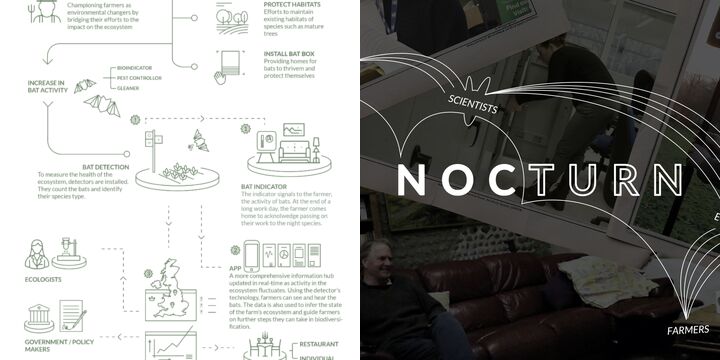NocTurn: Bat-Friendly Farming
The Problem
Bats, the ecosystem bioindicators, are essential to agricultural and pastoral practices, they are being lost in the scene and farmers are being blamed. Bats are keystone species, having a disproportionately large responsibility to the ecosystem they live in. Their role is vital to sustaining life within the environmental bubble and no other singular nor collective species would be able to compensate for their lost function upon extinction. Ecosystem service they provide includes pollination, seed dispersal, and pest control. From the agricultural perspective, the diet of bats consists of pests that largely overlap with the problematic species attacking crop harvest. Economic value of bats’ nontoxic pest-control services in agriculture is estimated at $3.7 to $53 billion per year. However, we are losing them. Many of the 1,300 species of bat are considered to be threatened and declining. One of the main reasons is the loss of habitats. Farmlands are potential to provide good habitat for bats, but how to incentivize and let farmers be aware of the underlying values? Farmers are criticised for the damage they cause towards the environment, often headlining their use of chemical agents like insecticides and fertilizers. Yet what doesn't get celebrated is their efforts into feeding and sustaining the nation. In current harvest-focused agricultural practices, it is difficult for farmers to recognize how their efforts towards the environment could effectively impact their yield.
Our Proposal
The project aims to champion farmers as environmental changers. Empowering them to diversify the species in their landscape through targeting bats and leveraging their function as bioindicators to bridge the information gap between farmer’s efforts and impact on harvest. 1. Bat Detector ii. Identification. An ultrasonic microphone is used to tether it’s captured files and sound-based machine learning algorithm is used to identify bat species. i. Counting. Existing bat detectors only pick-up the loudest and proximal sound, they don't always capture effective count numbers. Using infrared cameras, we adopt computer vision and A.I. technology to compensate for the counting. Collected data is automatically synthesized on the cloud and fed back into the farmer’s home indicator and their mobile application. 2. Indicator: Night shift. Farmers rest, bats work. Our indicator is the farmer’s home accessories. It doesn’t need to be fully attended but serves as a poetic reminder of the bats’ efforts through time. Concept ideas include mechanical wings that flap upon data received. It aims to build an emotional rapport between farmers and bats. 3. Mobile App: The app enables access to more pieces of data and guides farmers on further work they can get into for more impact. It shares images of peak moments in the night and allows users to listen to the bats on their own farms, which fascinates and a personal win comes from seeing your own. It also keeps a comprehensive log of past days.
We Assume that...
We assume behaviour change and data collection on bat habitat management can be applied to other keystone species in other ecosystem niches, eg. beavers in riverscape, and peccary in forest scape.
We assume acknowledgment of farmers as environmental changers can support their product. It allows farmers to step into movement of ecological farming and gain recognition for the effort by customers.
Constraints to Overcome
What is the gap that’s preventing them from currently working towards ecosystem diversification that coincides with their work. Current conservation parties approaches are militant. Farmers being proud people don’t get along well with extremes. Understandably, it’s discouraging. Secondly, though farmers are incredibly in tune with their land and soil they don’t always know whether or how their efforts to such a larger landscape are effective especially in impacting their current work. When they are so busy trying to look after their harvest, they find it unnecessary to adjust their long-adapted routines. Finally, the current way in which ecological surveys are performed is time-intensive and costly. Though the results are comprehensive, they are rather hard to understand to the average person let alone a farmer. Our bat detector is like the fit bit of the ecosystem health and indicators to monitor biodiversification of the greater ecosystem.
